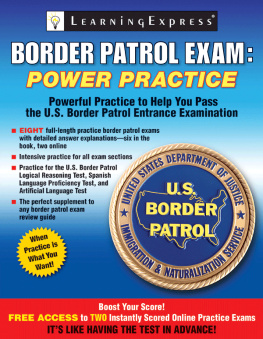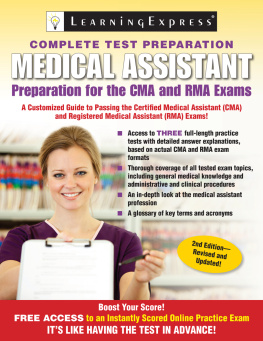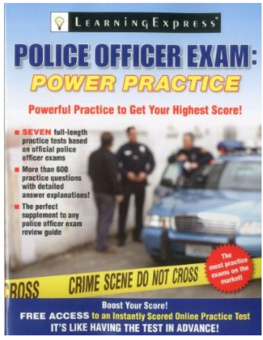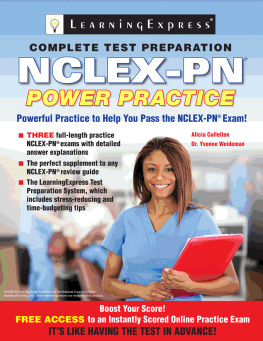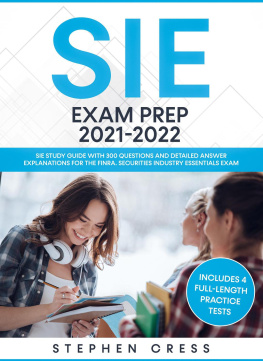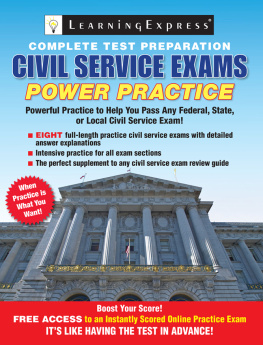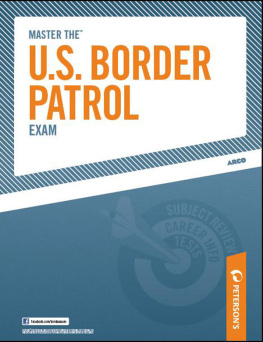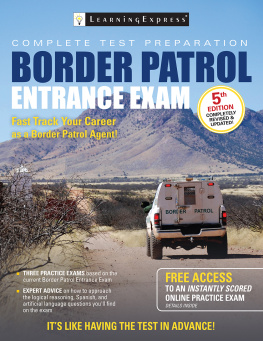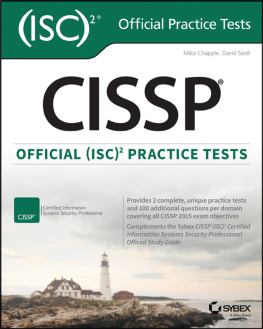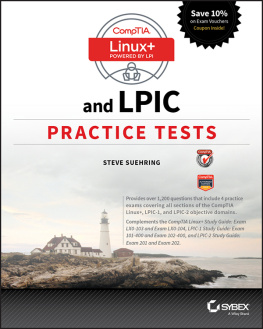Contents
CHAPTER 1 About the Border Patrol Exam
Logical Reasoning Test
Language Testing
CHAPTER 2 Border Patrol Study Skills and Test-Taking Strategies
Study Skills
Study Environment and Attitude
Learn How You Learn
Creating a Study Plan
What You Know and What You Need to Know
How Do You Know What You Know?
Learning Strategies
Border Patrol Exam-Specific Strategies
Timing
Multiple-Choice Test Strategies
Almost There: Strategies for the Final Days before the Exam
Handling and Preventing Test Stress
A Healthy Mind and a Healthy Body
CHAPTER 3 Practice Test 1
Logical Reasoning Test
Spanish Language Proficiency Test
Answers
Practice Test 1: Scoring and Diagnostic Chart
CHAPTER 4 Practice Test 2
Logical Reasoning Test
Spanish Language Proficiency Test
Answers
Practice Test 2: Scoring and Diagnostic Chart
CHAPTER 5 Practice Test 3
Logical Reasoning Test
Spanish Language Proficiency Test
Answers
Practice Test 3: Scoring and Diagnostic Chart
CHAPTER 6 Practice Test 4
Logical Reasoning Test
Artifical Language Review
Grammatical Rules for the Artificial Language
Artificial Language
Answers
Practice Test 4: Scoring and Diagnostic Chart
CHAPTER 7 Practice Test 5
Logical Reasoning Test
Artificial Language Review
Grammatical Rules for the Artificial Language
Artificial Language
Answers
Practice Test 5: Scoring and Diagnostic Chart
CHAPTER 8 Practice Test 6
Logical Reasoning Test
Artificial Language Review
Grammatical Rules for the Artificial Language
Artificial Language
Answers
Practice Test 6: Scoring and Diagnostic Chart
ADDITIONAL ONLINE PRACTICE
CHAPTER 1
About the Border Patrol Exam
E ach year, tens of thousands of people nationwide take the Border Patrol Exam, which is offered when current lists of eligible applicants are depleted and Congress authorizes additional hiring. Fewer than 800 of these candidates will be selected. Tests are normally scheduled at the nearest location to your home and could be administered in a federal building, civic hall, or library. You will be notified where to report for your written exam. When you receive the test notification packet, be sure to read all the material carefully!
You must pass a written exam like the practice tests contained in this book. The exam consists of the following sections: Logical Reasoning and a language test consisting of either the Spanish Language Proficiency Test or (if you dont speak Spanish) the Artificial Language Test (which tests your ability to learn languages). There is also an assessment of job-related activities and achievements.
The test takes about four and a half hours. Once you have taken the Border Patrol Agent test, you should receive a Notice of Results in the mail within four weeks following the test.
Logical Reasoning Test
The Logical Reasoning section of the test measures your vocabulary, reading comprehension, and critical thinking skills, which are necessary to prepare and perform the duties required of a Border Patrol Agent.
You should know that Border Patrol Agents are often called upon to testify in legal proceedings, and it is imperative to understand the legal reasoning process. The logical reasoning questions were designed with this application in mind. They are also designed to test your ability to understand complicated written material and derive conclusions. You will be required to come to logical conclusions based on various facts in the written material.
The questions in this test are different from regular reading comprehension questions that ask you to understand the meaning of a passage. Specifically, this is the kind of reading that will test your ability to draw conclusions and take action. Often, the situations presented in the questions can be quite complex. Careful reading and focused thinking are required to determine what is being asked and what is not being asked. The logical reading questions vary in level of difficulty from average to difficult.
Logical Reasoning Test Tips
When choosing a conclusion, always look for one that can be made based only on the information in the paragraph.
Assume all information in the paragraph is true. Do not use other factual information you may already know to reach your conclusion.
Focus on the key lead-in sentence and read the paragraph carefully. Consider all of the answer choices carefully before making your final answer selection.
Pay special attention to words such as all , some , none , unless , except , and only . These qualifying words help define the facts in the statement.
Keep in mind that negative prefixes such as non- or negative words such as disorganized or unfasten can be critical to an understanding of the information in the statement.
If for other tests you have been told to avoid answers that contain the word all or none , disregard that advice for the Logical Reasoning Exam. These words do not indicate an incorrect answer in this test. All and none can be in both the incorrect and the correct answers.
Answer every question on the test. Guess at an answer only after eliminating answers that you know to be false. While you are not penalized for guessing, your chances of picking a correct answer are greatly improved by using the process of elimination. You have a one in five chance of picking a right answer by blindly guessing. Your chances improve with every choice that is eliminated.
Do not pay attention to patterns made by a , b , c , d , or e on the answer sheet. Correct answer positions are selected randomly. You cannot improve your chances of guessing based on a pattern on the answer sheet. Trying to figure out a pattern is a poor test-taking strategy.
The best way to improve your chances on the exam is through practice. Take the tests found in this book and study their answer explanations. This will hone your logical reasoning ability. Remember that the time you put into preparing for the Logical Reasoning Exam is time well spent and will increase your chances of doing well on the test.
Language Testing
If you speak Spanish, you may take a proficiency test that measures that ability. However, if you do not speak Spanish, then you will take an Artificial Language Test that measures your ability to learn the Spanish language.
Spanish Language Test
There are four different kinds of questions on the Spanish Language Test.
1. Part IVocabulary
The best way to prepare for the vocabulary part of the test is to memorize, memorize, memorize. Using flash cards or a book of vocabulary lists, spend time every day drilling your vocabulary. This is an effective way to increase your Spanish comprehension and reinforce what you have already learned.
The surest way to do well on the test is to study your vocabulary as much as possible. However, even then, you may run across a key word or a choice you dont know. How do you proceed? A useful tip is to look not only for the meaning of the word but also for its part of speech. For example, is the word a noun, a pronoun, or a verb? Often, several choices can be eliminated just by observing that they are the wrong number and gender for the noun, the wrong pronoun, or the wrong form of the verb.
2. Part II, Section IGrammar
For this part of the test, the important thing to focus on is the grammar. Look for the combination of words that not only has an appropriate meaning but also matches grammatically. Look for obvious errors such as choices using the wrong number and gender or an incorrect verb form.
When evaluating verbs, begin by looking for the one with a form that matches the subject, which may be either a noun or a pronoun. Then look for one that uses the appropriate tense. This will quickly eliminate several possibilities. Often, it may not even be necessary to know the meaning of the verb to be able to choose the correct answer using this technique.

